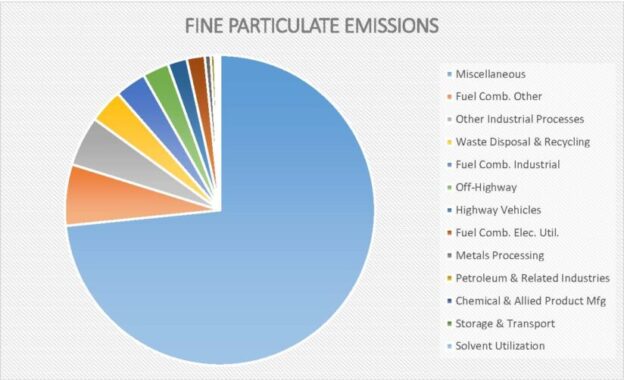When one happens to be a scientist with an expertise in environmental issues like yours truly, one has the opportunity to digest a disturbing number of misleading, eye-rolling headlines in the mainstream media as heavily-biased journalists vainly attempt to present accurate information about environmental issues.
Even by that ridiculously low bar, the headline that appeared in the May 5 edition of the Chicago Tribune rates as the most misleading, unscientific and mindlessly hysterical that I have ever seen. A major metropolitan newspaper in the United States actually printed the following:
Pollution from natural gas is now responsible for more deaths and greater health costs than coal in Illinois, according to a new study highlighting another hazard of burning fossil fuels that are scrambling the planet's climate.
Researchers at Harvard University found that a shift away from coal during the past decade saved thousands of lives and dramatically reduced health impacts from breathing particulate matter, commonly known as soot. But the numbers declined only slightly for gas, another fossil fuel that by 2017 accounted for the greatest health risks.
About half the deaths from soot exposure that year can be attributed to the state's reliance on gas to heat homes and businesses, the study found. Coal is more deadly only when used to generate electricity.
The alarming findings raise questions about whether Gov. J.B. Pritzker's proposed transition to a zero-carbon economy would move fast enough in phasing out the use of gas—not only to blunt the impacts of climate change but also to ensure Illinoisans breathe clean air.
The term “fake news” hardly covers it. This is “farcical news,” “fanciful news,” “delusional news,” etc. Yeah, journalists are not scientists. I get it. But, how sad it is to consider there is not one editor at the Trib who might have enough passing knowledge to think something like “that really doesn’t sound right, maybe we should take a second look.”
The essence of the Trib’s story, written by staff enviro-propagandist Michael Hawthorne, may be summarized thus:
Hawthorne does not actually use the accepted environmental terms “fine particulate” and “PM-2.5” in his story. Instead, he calls fine particulate “soot.” Certainly, that’s a much more appealing term to someone attempting to create a narrative, but it has little to do with reality. When you call in a chimney sweep to remove actual soot from your fireplace, almost none of the black gunk he or she will brush off is anything close to 2.5 microns in aerodynamic diameter.
Anyway, the problem with this particular narrative is the same one that always occurs when people with an agenda attempt to dragoon science into supporting their political agenda: they use that portion of the science that helps them and ignore (willingly or ignorantly) any of the science that disproves their premise.

I can accept that the amount of PM-2.5 generated though the combustion of natural gas now exceeds the amount of PM-2.5 generated by through the combustion of coal. At least theoretically. The amount of PM-2.5 generated by the combustion of natural gas is relatively so tiny that it is very, very difficult to accurately measure using accepted EPA test methods. In the enviro-biz, one errs on the side of caution, meaning that PM-2.5 emission rates attributed to natural gas are likely inflated.
Doesn’t really matter though, since the amount of PM-2.5 emissions that can be tied to electrical generation of any kind is trivial. Based on the last verified National Emissions Inventory (NEI) of 2017, the total amount of PM-2.5 emissions generated across America was 5,706,842 tons/year. Of that, EPA attributed 107,270 tons/year of fine-particulate emissions to fossil fuel combustion used to generate electricity. That’s less than 2 percent of all national PM-2.5 emissions.
Wondering about the biggest source of PM-2.5 emissions? Glad you asked. The 2017 NEI attributes 4,188,615 tons/year of PM-2.5 emissions to “Miscellaneous Sources.” That’s a shade over 73 percent of the total. Miscellaneous sources are non-industrial, non-transportation related sources of all kinds. In this case, the vast majority of miscellaneous sources consist of wildfires – many of which are the result of pitifully irresponsible forest management in blue states like California – and natural erosion.
Back in the nineties and early 2000s, environmental NGOs like the Sierra Club were all-in supporting natural gas. They recognized that natural gas combustion was inherently cleaner than coal combustion and that the amount of greenhouse gas produced using natural gas was far lower than that amount of greenhouse gas produced using coal on a per megawatt generated basis. They gleefully accepted donations from natural gas producers in order fund initiatives like the Sierra Club’s “Beyond Coal” campaign.
Chesapeake Energy, the nation’s second largest natural gas producer, was a big Sierra Club supporter back then, presumably because Chesapeake executives hoped that going “beyond coal” would help their bottom line. They didn’t have the foresight to see that once the enviros actually went beyond coal, natural gas would be the next target of opportunity. I’ve been told by people I trust that several Chesapeake shareholders were something less than pleased when the Sierra Club pivoted from being a natural gas supporter to a natural gas opponent, which is where they and most of their fellow environmental NGOs remain today. In the business of environmental advocacy, as is the case with any other big business, one has to follow the money.
It’s a disappointing story, but I fear that Chesapeake will be far from the last company to jump at the bait when an environmental NGO offers them absolution in return for thirty pieces of silver.
Natural gas makes
Half as much CO2 as
Coal per megawatt.
=============
The ignorance of journalists and policy makers is absolutely jaw-dropping. Fires are WAY more important sources of fine PM.
Well, the only good news relative to the above article is that virtually no one reads the Chicgo Tribune!